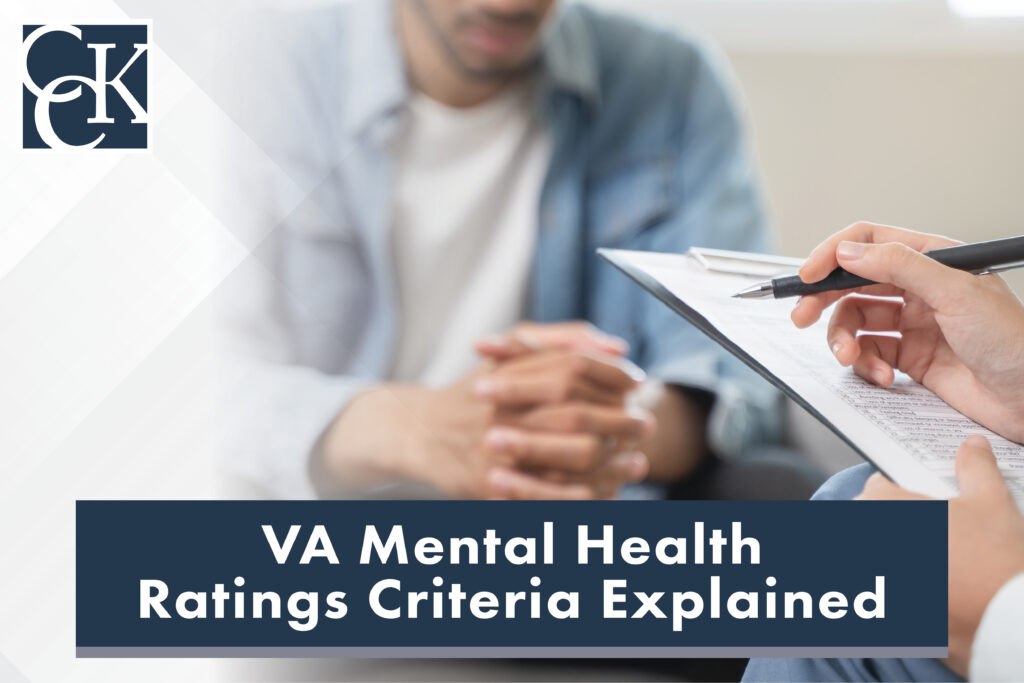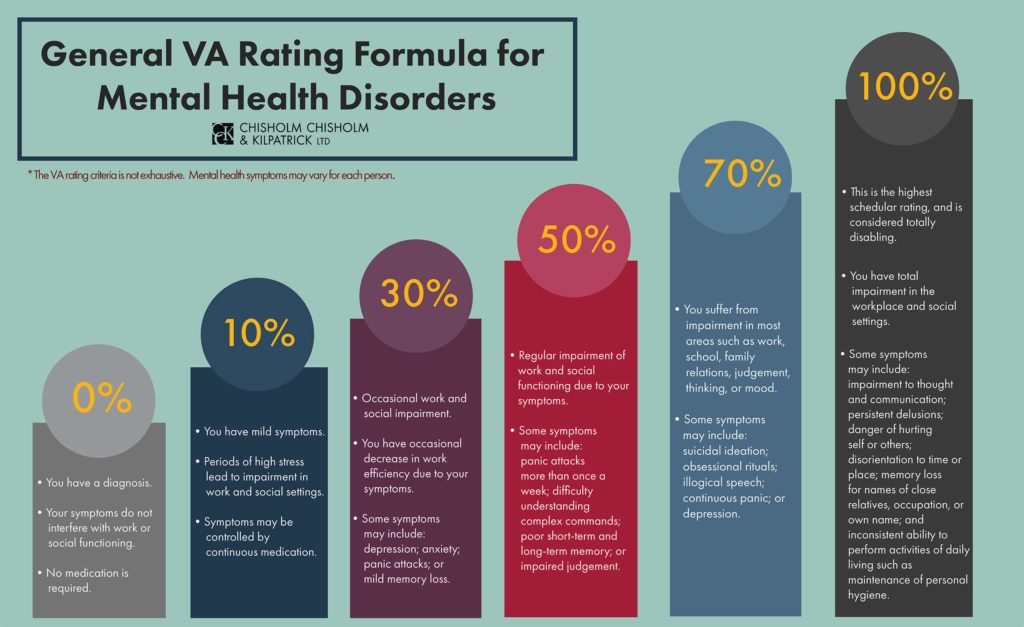VA Mental Health Ratings Criteria Explained

CCK Law: Our Vital Role in Veterans Law
After VA approves a veteran’s disability claim for mental health, it assigns a rating based on occupational and social impairment using criteria from the General Rating Formula for Mental Disorders (38 CFR § 4.130). This rating determines monthly compensation and additional benefits. Therefore, it is crucial that a veteran’s VA disability claim or appeal properly communicates their mental health symptoms.
The top points of this article include:
- VA mental health disabilities that were caused or aggravated by military service can receive ratings of 0, 10, 30, 50, 70, and 100 percent. Each rating has its own set of criteria to assess occupational and social impairment.
- VA mental health ratings are influenced by VA medical records and C&P exams, but other evidence like lay statements and private treatment records can play a key role in maximizing VA disability compensation.
- High ratings for VA mental health conditions may make a veteran eligible for additional compensation through programs like individual unemployability or special monthly compensation.
NOTE: The Veterans Crisis Line is free, confidential, and available 24/7. Ways to access:
- Dial 988 and pressing 1
- Chat online at https://www.veteranscrisisline.net/get-help-now/chat/
- Send a text message to 838255

How Does VA Assign Mental Health Ratings?
The process for determining a VA mental health rating involves collecting evidence from a number of potential sources, starting with service and medical records. C&P exams, lay evidence, and independent medical examiners can also play key roles.
C&P Exams
To assist VA with rating a mental health disability, a veteran may be required to attend a Compensation and Pension (C&P) Exam.
VA may use a Mental Health Disability Benefits Questionnaire (DBQ). This is a form used by VA to evaluate a veteran’s mental health with regard to disability compensation. A VA medical professional will typically fill out this form during the C&P exam itself. A DBQ plays an important part in the claim process because it is a structured assessment that can be used as evidence for the claim. For more information, read CCK’s article on DBQs.
Lay Evidence
Lay evidence—such as statements from friends or family members about their observations of the veteran—can play a critical role in increasing VA mental health ratings.
VA mental health ratings depend heavily on subjective evidence. Examinations and treatment documentation often do not provide a comprehensive enough picture to support an accurate VA rating for mental health disorders. Lay statements can fill important gaps in the record, especially in regards to social and occupational impairment.
“VA often takes lay evidence with almost the same weight as medical evidence. So that is something we really look into, especially for a psychiatric condition.” —CCK Supervising Agent Michelle DeTore.
Private Medical Records
“A treating physician might have access to more long-term assessments and evaluations of your mental health symptoms over the course of many years, as opposed to just that single snapshot of the severity of your symptoms on the day of the exam,” says Nicholas Briggs, CCK Senior Appeals Advisor. “So, anything you can do to provide treatment records over a longer period of time, the better off you may be in terms of getting the increased rating granted.”
Note that while VA has a duty to assist the veteran in collecting relevant evidence, the veteran may need to provide private medical records to VA or assist VA with locating and requesting them.
Veterans can also consider getting an outside independent opinion from a psychologist or other professional who has the expertise to assess the severity of psychiatric symptoms.
“It is even better if that expert has the ability to review your file in its entirety including any lay testimony that you have submitted,” says Briggs. “The more analysis that that expert is able to provide in support of their opinion, the stronger and more probative that opinion is likely to be considered by VA.”
What is the General Rating Formula for Mental Disorders?
The rating criteria for VA mental health ratings can be found in 38 CFR § 4.130 – Schedule of ratings—Mental disorders. Mental health conditions can receive ratings of 0, 10, 30, 50, 70, and 100 percent. Each rating has its own set of criteria and examples to assess occupational and social impairment.
Mental health conditions, such as post-traumatic stress disorder or bipolar disorder, can manifest differently per individual. Therefore, symptoms listed in each level of the rating formula are simply examples meant to demonstrate the types and levels of impairment commonly found at the assigned percentage rating. Veterans do not need to exhibit the exact symptoms listed in the rating criteria to receive that particular mental health rating.
For example, a veteran may be so anxious that they pick their skin, which causes physical harm to themselves. This is seen as a self-injurious behavior. It is also considered an obsessive ritual that can interfere with routine functioning. Though skin picking is not a symptom that is listed in the rating criteria, because it is similar to other symptoms that are listed, it could contribute to a 70 percent disability rating.
If VA denies or underrates a mental health claim due to applying the symptom examples too strictly, the veteran should consider an immediate appeal.

100 Percent VA Mental Health VA Disability Rating
The criteria for a 100 percent VA mental health disability rating encompasses total occupational and social impairment. This impairment must be due to symptoms such as:
- Gross impairment in thought processes or communication
- Persistent danger of hurting self or others
- Intermittent inability to perform activities of daily living
- Disorientation
- Memory loss for names of close relatives, own occupation, or own name
In other words, the veteran’s mental health is so severe that it affects all aspects of their daily life.
70 Percent VA Mental Health VA Disability Rating
A 70 percent disability rating is the second-highest possible rating for a mental health condition. While the criteria are less severe than the 100 percent rating, the veteran will still have trouble developing and maintaining social relationships and may have serious difficulty securing substantially gainful employment.
A 70 percent VA mental health disability rating requires that veterans have occupational and social impairment with deficiencies in most areas, such as:
- Work
- School
- Family relations
- Judgment
- Thinking
- Mood
Veterans at this rating may have suicidal ideation, obsessional rituals that interfere with routine activities, illogical speech, near-continuous panic or depression, and more.
Note that there are a number of ways in which a veteran with a 70 percent rating may potentially raise it to 100 percent. For example, a veteran with a VA mental health rating of only 70 percent may still be eligible for 100 percent disability benefits if they are unable to find or maintain substantially gainful employment. Learn more about TDIU for mental health in the section below.
50 Percent VA Mental Health Disability Rating
A 50 percent rating for a mental health condition, while still significant, is not as severe as a 70 percent rating. The veteran’s mental health condition may interfere with their ability to work or go to school. Yet it does not stop them from engaging completely.
Further, their mental health condition will affect their social relationships to a lesser degree than a veteran who might have a higher rating. Anxiety and panic attacks may still occur but not as frequently as is required for the 70 percent rating.
30 Percent VA Mental Health Disability Rating
Veterans with a 30 percent disability rating for a mental health condition still experience a decrease in work performance but only occasionally. Typically, the veteran is functioning to a standard degree, but there may be some days in which they are more affected than others.
Under a 30 percent mental health rating, the veteran will still have intermittent periods with an inability to perform occupational tasks. This may be due to depressed mood, anxiety, panic attacks, and more.
10 Percent VA Mental Health Disability Rating
A 10 percent disability rating for mental health conditions has even less severe symptomology than the other ratings. Symptoms may include mild depression or anxiety. It may also include mild or rare panic attacks, occasional difficulty sleeping, and more.
Overall, the 10 percent rating means that the veteran’s symptoms are very mild and do not consistently affect the veteran daily—perhaps only during times of high stress.
0 Percent (“Non-Compensable”) VA Ratings and Why They Matter
Finally, a 0 percent disability rating (i.e., non-compensable rating) for mental health conditions is warranted when the following is true: “A mental health condition has been formally diagnosed, but symptoms are not severe enough either to interfere with occupational and social functioning or to require continuous medication.”
Even though a VA rating of zero percent may not result in monthly compensation, it is still valuable to have VA recognize that a service-connected mental health condition exists. For example:
- “If you’re service connected at a non-compensable disability rate and you come to believe that that condition has gotten worse over time, you can go ahead and file a claim for an increased rating, which is a little bit easier,” says Brandon Paiva, CCK Lead Advocate.
- Also, a non-compensable rating still qualifies the veteran for benefits like a higher priority group for VA health care.
Additional Factors that May Affect VA Mental Health Ratings
What If a Veteran Has Multiple Mental Health Conditions?
VA does not consider the number of mental health conditions a veteran has. Instead, it considers the severity and impact of each condition and will assign a single overall disability rating. This is due to how often mental health conditions share similar symptomology. Receiving two ratings would be considered pyramiding.
For example, a veteran may suffer from both depression and anxiety. While VA has two diagnostic codes for these conditions, it will still rate these conditions based on symptoms and impairment—regardless of source condition—resulting in the veteran receiving a single rating of 50 percent for both service-connected conditions.
TDIU: What If a Veteran with a VA Mental Health Rating Cannot Work?

A mental health condition can impair a veteran’s ability to work. Total Disability based on Individual Unemployability (TDIU) allows veterans who are not rated as 100 percent disabled to still be compensated at a 100 percent rating level due to their conditions preventing them from holding “substantially gainful” employment.
Schedular TDIU requires either a rating over 60 percent or a combined rating of at least 70 percent with at least one condition being rated over 40 percent. For example, if VA rates a mental health disability over 70 percent, TDIU is possible.
However, TDIU claims can be highly complex and time-consuming, particularly in the cases of subjective claims like mental health, so utilizing the services of a VA-accredited law firm or agent is recommended.
Special Monthly Compensation (SMC) for Mental Health Conditions
Veterans may have service-connected disabilities so severe that they warrant a VA rating higher than 100 percent. A VA monetary benefit called Special Monthly Compensation (SMC) allows for this. VA SMC for mental illness can compensate a veteran for the additional aid and attendance or limitations that are part of their life.
How Much Is VA Compensation for Mental Health Ratings?
As of 2026, the VA disability rate benefit amounts are as follows:
- 0 percent disability rating: $0.00 per month
- 10 percent disability rating: $180.42 per month
- 30 percent disability rating: $552.47 per month
- 50 percent disability rating: $1,132.90 per month
- 70 percent disability rating: $1,808.45 per month
- 100 percent disability rating: $3,938.58 per month
If a veteran is receiving 30 percent in VA disability compensation or higher and has one or more qualifying dependents, then they are eligible for additional compensation.
Qualifying dependents include:
- A spouse
- Dependent parents
- A child under the age of 18 or between 18 and 23 and still in school
- An additional child under the age of 18
- An additional child between 18 and 23 who is still in school
So, for example, if a veteran is rated at 50 percent and also has one dependent parent, then their 2025 monthly compensation rate would be $1,187.11, while their 2026 compensation rate would be $1,220.35.
How to Appeal or Increase Your VA Rating
Veterans may wish to appeal or increase their VA rating. They may wish to do this for several reasons, including:
- VA denied their claim incorrectly
- The veteran believes their rating should be higher or that they may now be eligible for TDIU
- An existing condition worsened
- A secondary condition developed
In these types of situations, veterans have options for appealing or filing supplemental claims.

Denied or Underrated for VA Disability for Mental Health? Call CCK Today
Appeals can be difficult and time-sensitive. Also, veterans have likely already experienced lengthy delays waiting for their initial rating. Therefore, the law permits disabled veterans to hire a VA-accredited law firm or advocate to assist with appeals.
If you are appealing an unfavorable VA decision, contact CCK, the most experienced veterans law firm in the U.S. You may call (800) 544-9144 or contact us online for a free case evaluation with a member of our team.
About the Author
Share this Post
